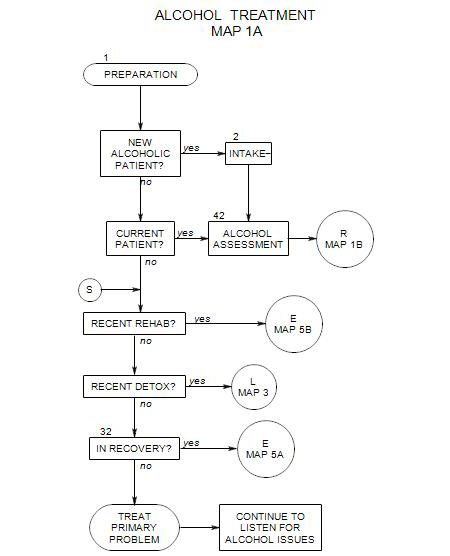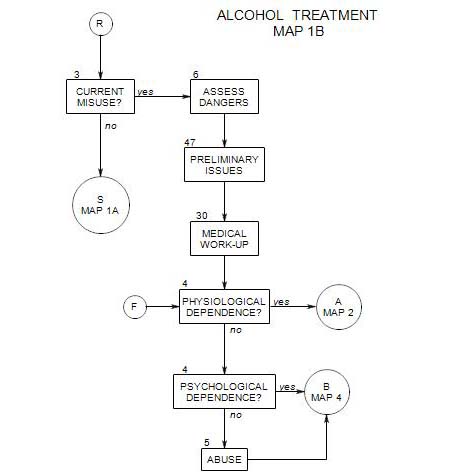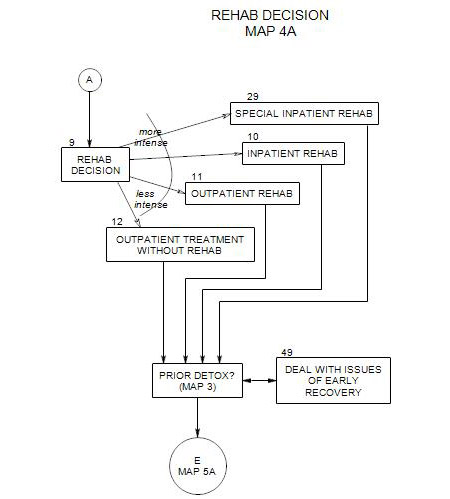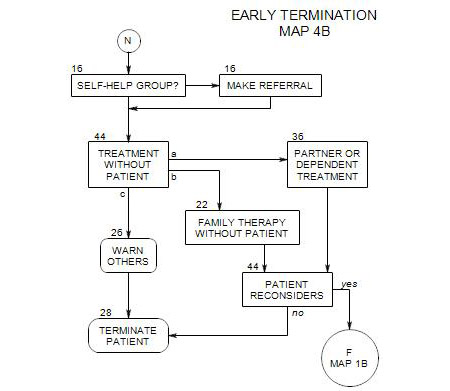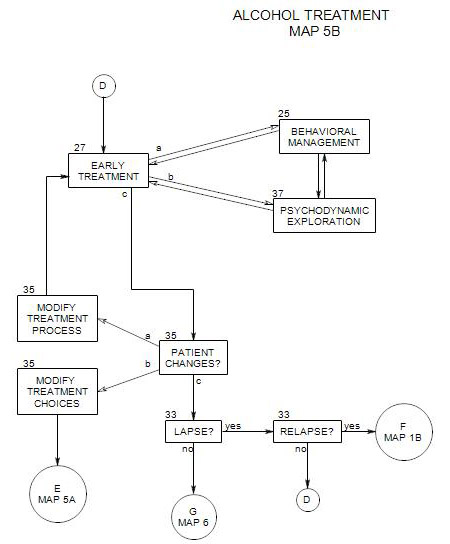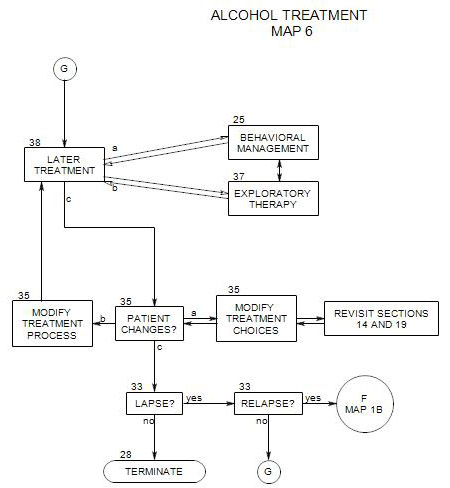3. DOES A PATIENT USE/MISUSE ALCOHOL?
- This section is intended to be used in conjunction with Section 2, making use of information gathered in intake sessions. It leads to Section 6 if you decide that the patient is misusing.
A routine check of the amount and frequency of a person’s alcohol use can sometimes turn up important information about a person. Many people drink occasionally or regularly without a problem. For them, asking about their alcohol consumption can still lead relevant therapeutic issues that you might not have considered otherwise. You might learn about their personal histories with drugs and alcohol, a family history of misuse, issues with a spouse, children or friends. These and other issues could be affecting the person’s psychological status and be worthy of exploring.
People drink for various “reasons”, for example, on social occasions, for relaxation, and for enjoyment. Some people drink regularly, in a temperate way, which may not pose a problem. The core issues are [1] whether the person has real choices about whether to drink and how much to drink, and whether the choices are made in a reasonable way; and [2] whether alcohol use is having a negative impact on the person’s life.
Finding out about a person’s alcohol misuse may clarify his/her presenting symptoms and complaints or predict the course of treatment.
- What might otherwise be considered psychotherapeutic issues could be the consequences of drinking.
- Alcohol misuse can undermine psychotherapy, as when the patient drinks after sessions or fails to work through issues raised in treatment.
- Interpersonal or intrapsychic issues may be used to justify alcohol misuse.
The interplay of disabilities is often complicated.
- Alcohol use may be the patient’s way of trying to self-medicate for the other condition. It may also cause other conditions or exacerbate them.
- The use of alcohol as a way of managing a person’s physical or emotional pain may interfere with psychological treatment, medical treatment or both.
- When a person is dealing with alcohol and some other condition, it is not clear in the abstract which disorder should be treated first, or whether they should be treated simultaneously.
- Alcohol dependence may also mask other disorders, to the point that you may be unsure of a patient’s comorbid condition until the patient has been sober for a period of time.
Many professionals recommend a period of abstinence prior to treatment of other psychological conditions, to clarify the diagnostic picture. However, some patients may not be able to remain abstinent because of habit, social pressure, or their other physical or psychological issues.
Alcohol is a central nervous system depressant, affecting a person’s entire brain and nervous system. Its impact is pervasive, but specific consequences are more obvious in some people than others. Part of asking about includes asking about its effect on a person: “What’s it doing for you?”
3a. Caveat
It is important to ask about personal and family alcohol use in detail; however, when a patient is misusing alcohol, you can usually assume that he/she will under-report his/her own drinking behavior. This could happen for many reasons. He/she may –
- expect criticism from you.
- worry about legal repercussions.
- feel guilty and hold back.
- be hiding from others and fear you will pass the information on to them.
- be deceiving him/herself.
- have a poor memory.
3b. Benign Use of Alcohol
For most people, alcohol misuse isn’t an issue; and if you are working with one of these, it is time to focus on other issues. Simply continue to listen for indicators that the person has misused on occasion. If a pattern of misuse should eventually emerge, you can then reconsider ways of handling it. One way would be to start over with the alcohol treatment map presented here, seeing the patient from a new perspective.
The NIAAA [National Institute for Alcohol Abuse and Alcoholism] offers the following guideline to distinguish moderate from problematic use [FAQs for the General Public]:
For most adults, moderate alcohol use–up to two drinks per day for men and one drink per day for women and older people–causes few if any problems. (One drink equals one 12-ounce bottle of beer or wine cooler, one 5-ounce glass of wine, or 1.5 ounces of 80-proof distilled spirits.)
There are also exceptions. Pregnant women should never drink alcohol because of its potential for damaging a developing fetus. Alcohol may interact with certain medications to either multiply or reduce their effect, etc.
3c. Recommendations for Non-Misuser
In most cases, if a person is not misusing alcohol, you will move on to other therapeutic issues or consider termination.
However, under some circumstances, you may believe that a patient is neither dependent nor abusing but recommend some further exploratory work, just to be sure. (For example: a young man is accused of assault while intoxicated and referred by the court. You believe he wasn’t intoxicated and didn’t commit the assault. You might still recommend several exploratory therapy sessions and a few AA meetings. In those sessions, you could continue to listen for alcohol abuse.)
3d. Alcohol Misuse
The term misuse is used here as a general term for either abuse or dependence. Dependence is discussed in Section 4 and abuse in Section 5. In either case, the person’s use is problematic in a serious way, and has negative consequences to the drinker or to others. Those consequences may be seen as indicators that the person’s judgment has been compromised relative to alcohol, and that there is loss of control of functioning where alcohol is concerned.
Drinking may be considered a serious problem when a person…
- consumes more than initially intended.
- drinks to manage emotional issues such as anxiety, rejection, depression or anger.
- has tried to reduce intake, without success.
- has given up social or occupational activities for drinking.
- has had to face serious work, relationship, financial or legal issues that were attributable to drinking or exacerbated by it.
- spends time and energy achieving the effect or recovering from it.
- knows that alcohol has negative consequences but continues to drink.
- engages in other dysfunctional behavior, which he/she may or may not be aware of, in connection with or as a consequence of drinking.
It is more indicative of dependence than abuse, if a person –
- needs to drink in order to function [e.g.: socially or at work].
- uses alcohol regularly to function [e.g.: to relax or go to sleep].
- has increased tolerance, and needs to drink more than in the past to achieve the desired effect.
Any one of the above issues can be an indicator of a serious problem; there is no need to add them to get a score.
Once it appears likely that a person is misusing alcohol, each of the above areas should be discussed, in order to get a better picture of the person’s problem. Still, you shouldn’t expect to get the whole picture at this time. People typically don’t admit the full extent of their alcohol use for a variety of reasons, especially this early in treatment.
If there is evidence of misuse, then this is a good point either to start pressing the patient to give up drinking, at least temporarily, or to reduce drinking sufficiently so that the diagnostic picture is clarified. If the patient won’t or can’t abstain even temporarily, keep abstinence in mind as a goal to return to.
3e. Forms of Use and Misuse
There are many ways to categorize the forms of using alcohol [see Washton and Zweben, 2006, pg 24 – 27]. These include
Experimental use, in which a person tries out alcohol or another substance for a first time. Typically benign, this kind of exposure can be dangerous and/or can lead to more serious involvement
Occasional use, in which the alcohol or other drug is used in small quantities and infrequently. This is also generally not dangerous, but could become so. It can also drift into regular use.
Regular use, when a person uses alcohol or other substances more often and in a consistent way. Use may be temperate, or not. When it is not, it can easily become dependence or abuse.
Situational use, where drinking or drug use are linked to a particular occasion or circumstance. Here the substance or alcohol is used to cope with the situation in some way [e.g.: to deal with anxiety or to fit in]. It can easily become psychological dependence over time, if the person comes to believe that drinking is necessary in order to cope with the situation.
Binge drinking, when a person uses large quantities of alcohol or other substance in a short period of time. This kind of use has a number of associated issues, including increased risk because the person isn’t used to drinking, and the possibility that the person won’t see this form of drinking as a problem. But of course, there can be consequences of consuming large quantities of any substance which the person is not accustomed to experiencing. In addition, this kind of use can easily become abuse.
Abuse, [ Section 5 ] in which a person may be neither psychologically nor physiologically dependent, but when he/she uses, there is a high risk of negative consequences.
Psychological Dependence, where a person needs alcohol in order to function, especially socially or vocationally. [ Section 4 ]
Physiological Dependence, [ Section 4 ] where a person’s body has adapted to constant alcohol use to the point that stopping leads to physiological withdrawal symptoms.
Often there is a progression in misuse, from abuse to psychological dependence, to physiological dependence [see Section 4 ].
